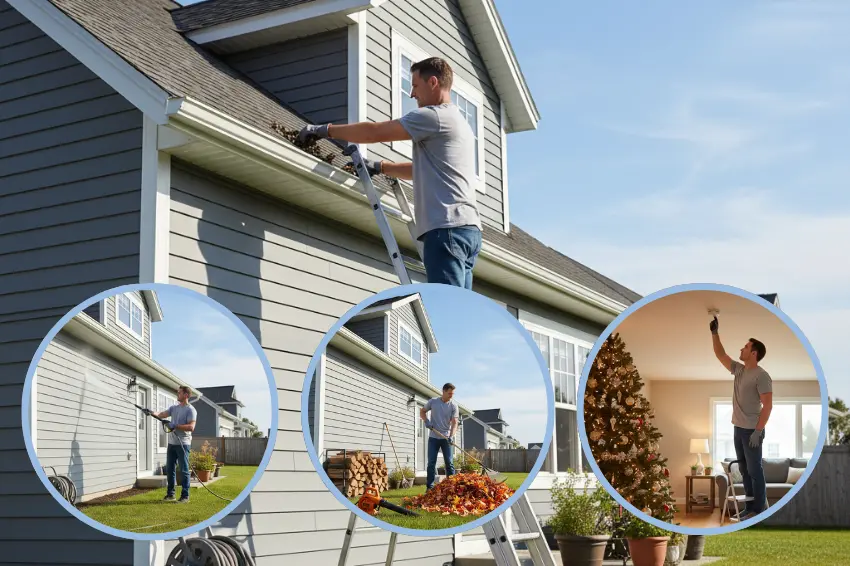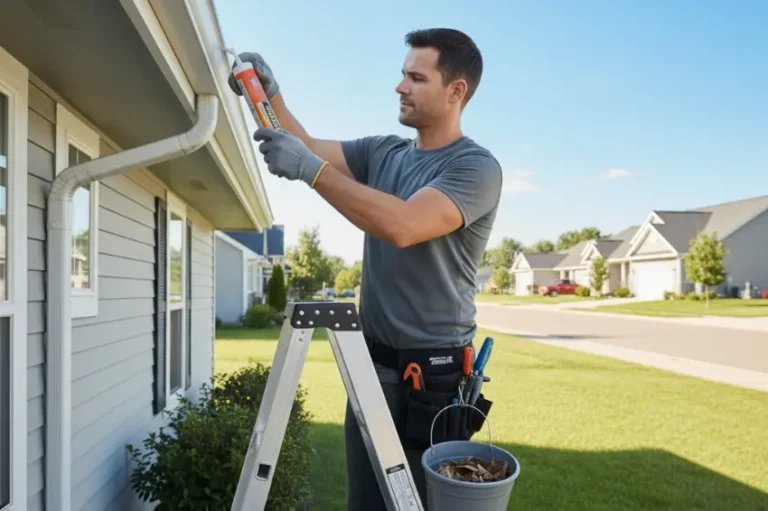Okay, real talk—home maintenance can feel like a never-ending to-do list that just keeps growing. One day you’re noticing a weird water stain on the ceiling, the next your gutters are overflowing, and suddenly you’re Googling “how much does a new roof cost?” at 2 AM. We’ve all been there.
But here’s the thing: staying on top of home maintenance doesn’t have to be overwhelming or expensive. Think of it like going to the dentist (stay with me here!)—a little preventative care now saves you from major headaches (and major bills) later. I learned this the hard way when I ignored a tiny roof leak that turned into a $3,000 repair. Not my proudest moment.
This guide breaks down home maintenance into manageable seasonal chunks, so you’re never scrambling or wondering what you should be checking. Whether you’re a first-time homeowner or you’ve been at this for years, having a system makes all the difference. Plus, I’ll share some budget-friendly hacks and tools that actually make these tasks easier. Let’s keep your home in great shape without breaking the bank or losing your weekends.
Spring: The Fresh Start Your Home Needs
Spring isn’t just about cleaning—it’s about catching problems before they become expensive disasters. After a long winter, your home needs a little TLC.
Inspect Your Roof and Gutters
Winter weather can be brutal on your roof. Grab some binoculars (no need to climb up there if you’re not comfortable) and look for missing or damaged shingles, cracks, or any signs of wear. Even small damage can lead to leaks during spring rains.
Gutters are the unsung heroes of your home. Clogged gutters mean water backs up and can damage your roof, siding, or foundation. Trust me, cleaning gutters is way cheaper than fixing foundation cracks. Use a sturdy ladder, wear gloves, and scoop out all that debris. A garden hose helps flush out remaining gunk. If you’re not into heights, a Power Washer (like the RYOBI model) works wonders from the ground for the final rinse.
Pro tip: Installing gutter guards after cleaning can cut your maintenance time in half next year. They’re not perfect, but they keep out most leaves and debris.
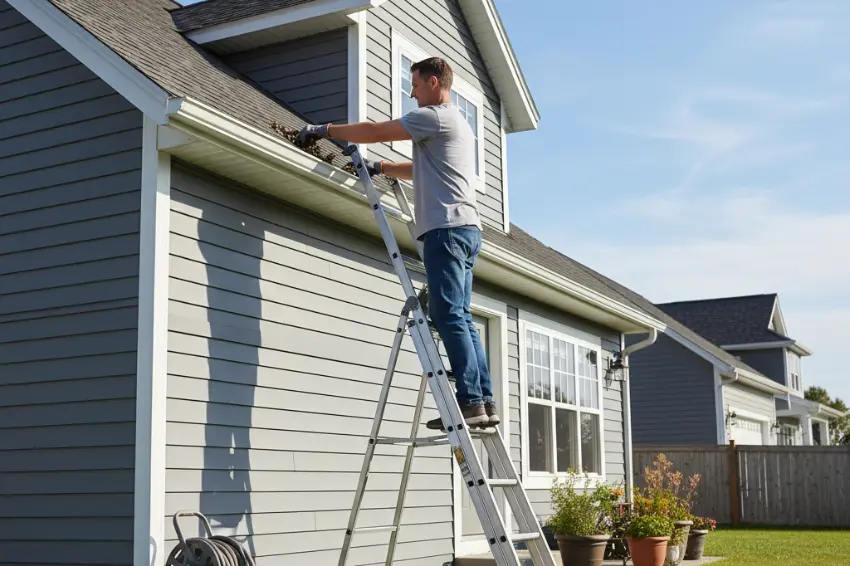
HVAC System Check-Up
Your air conditioning has been hibernating all winter. Before the first heat wave hits, change your HVAC filter (more on this later—it’s actually a monthly thing), and consider scheduling a professional tune-up. A well-maintained AC runs more efficiently, which means lower energy bills.
Clean around your outdoor AC unit too. Remove leaves, grass clippings, and any debris that accumulated over winter. Give it at least two feet of clearance on all sides for proper airflow.
Exterior Power Washing
Nothing makes your home look fresher than a good power wash. Hit your siding, deck, driveway, and walkways. This removes built-up dirt, mold, and mildew that can cause long-term damage. The RYOBI Pressure Washer is affordable and surprisingly powerful for home use.
A word of caution: Be gentle with painted surfaces and wood. Too much pressure can damage siding or strip paint. Start with a lower setting and work your way up if needed.
Lawn and Garden Prep
Spring is prime time for lawn care. Rake up dead leaves, aerate compacted soil, and overseed bare patches. For your garden beds, add fresh mulch—it keeps weeds down and helps soil retain moisture.
Budget hack: Don’t buy expensive mulch. Many municipalities offer free mulch made from yard waste. Check your city’s website.
Summer: Maintain What’s Working
Summer maintenance is about keeping everything running smoothly when your home is working hardest—especially your cooling systems.
Monthly HVAC Filter Changes
Here’s something most people don’t do enough: change your HVAC filter every 30-60 days, especially in summer when your AC is running constantly. A dirty filter makes your system work harder, wastes energy, and can lead to breakdowns.
Set a phone reminder. Buy filters in bulk (they’re cheaper that way). This is literally the easiest preventative maintenance you can do, and it makes a huge difference.
Check Windows and Doors
Walk around your home and check the caulking and weatherstripping around windows and doors. Gaps mean your AC is cooling the outdoors (expensive!). Re-caulk anywhere you see cracks or gaps. It’s a small investment that pays off immediately in lower energy bills.
Inspect and Clean Kitchen Appliances
Your refrigerator coils collect dust and grime, making your fridge work harder. Pull it out (I know, I know) and vacuum the coils. Do this twice a year, and your fridge will thank you with years of extra life.
Run your dishwasher empty with a cup of white vinegar to clean out buildup. Check your garbage disposal for clogs and grind some ice cubes with citrus peels to freshen it up and sharpen the blades.
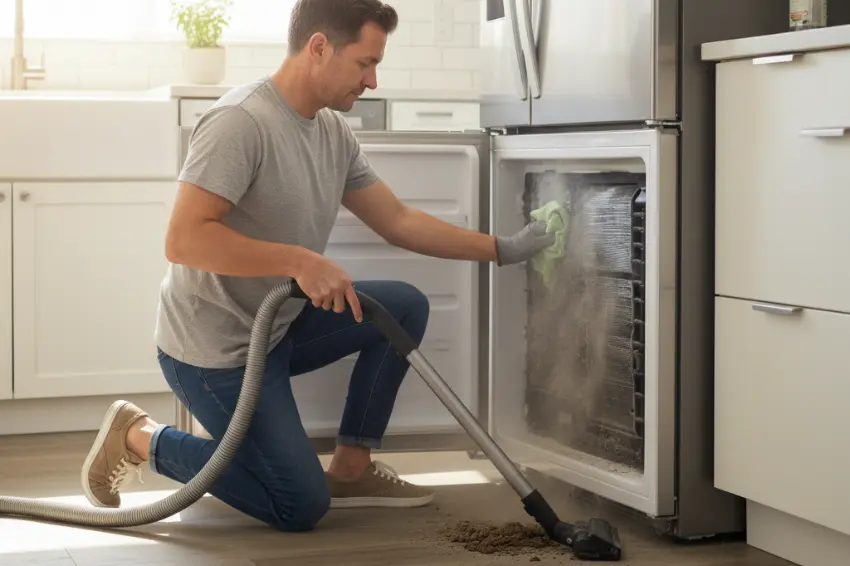
Deck and Patio Maintenance
If you have a wood deck, summer is when you’ll notice any problems. Look for loose boards, popped nails, or splintering wood. Sand down rough spots and consider resealing or staining if the wood looks dry or faded.
For concrete patios, fill any cracks with concrete filler before they spread. Small cracks become big cracks become expensive replacements.
Fall: Prepare for Winter
Fall maintenance is all about winterizing—getting your home ready for cold weather before it arrives.
Heating System Preparation
Just like your AC needed attention in spring, your furnace needs love in fall. Change the filter, test the system by turning it on, and schedule a professional inspection if you haven’t had one in a couple years.
Don’t skip this. A malfunctioning furnace in January is nobody’s idea of fun, and emergency repair rates are brutal.
Outdoor Faucet Winterization
This is crucial if you live anywhere that freezes. Disconnect garden hoses, drain outdoor faucets, and shut off the water supply to exterior spigots. If water freezes in your pipes, they can burst—causing thousands in water damage.
Install insulated covers on outdoor faucets for extra protection. They cost about $3 and could save you thousands.
Chimney and Fireplace Inspection
If you have a fireplace, get your chimney inspected and cleaned annually. Creosote buildup is a fire hazard, and birds or squirrels sometimes nest in chimneys during summer (ask me how I know).
A professional chimney sweep costs $100-200, but it’s essential for safety and efficiency.
Gutter Cleaning (Again)
Yes, gutters need cleaning twice a year—spring and fall. Those beautiful fall leaves? They all end up in your gutters. Clean them out after most leaves have fallen but before the first freeze.
Seal Gaps and Cracks
Walk around your home’s exterior looking for gaps where cold air could sneak in. Check where pipes, wires, or vents enter your home. Seal these with caulk or expanding foam. Even small gaps let in cold air and pests.
Winter: Indoor Focus and Safety Checks
Winter maintenance shifts indoors. It’s too cold for most outdoor projects, so focus on interior systems and safety.
Test Smoke and Carbon Monoxide Detectors
This is non-negotiable. Test your smoke and CO detectors monthly by pressing the test button. Replace batteries twice a year (I do it when we change clocks for daylight saving time—easy to remember).
Replace the entire unit every 10 years. Check the manufacturing date on the back. Detectors lose sensitivity over time, and they’re too important to skip.
Check for Drafts
On a cold, windy day, do the “hand test” around windows and doors. Feel for cold air coming through. If you find drafts, use weatherstripping, door sweeps, or even temporary plastic window insulation kits to seal them.
Budget-friendly trick: A rolled towel along the bottom of a drafty door works surprisingly well until you can install a proper door sweep.
Inspect Plumbing for Leaks
Check under sinks, around toilets, and near your water heater for any signs of leaks or moisture. Winter puts stress on pipes, and small leaks can become big problems. Tighten any loose connections with an Adjustable Wrench.
Know where your main water shutoff valve is and make sure it works. If a pipe bursts, you need to shut off water immediately.
Reverse Ceiling Fans
Most ceiling fans have a switch that reverses direction. In winter, run fans clockwise (when looking up) on low speed. This pushes warm air down from the ceiling, making rooms feel warmer without cranking up the heat.
Interior Deep Clean
Winter is perfect for tackling indoor cleaning projects. Use a Eufy Handheld Vacuum for quick cleanups and a Bissell Portable Shampooer for spot-treating carpets and upholstery. The Scrub Daddy Damp Duster is genuinely great for catching dust without just moving it around.
For floors, the Bona Spray Mop leaves no residue and dries fast—perfect for hardwood or laminate. Keep Mop Head Replacements on hand so you’re always cleaning with fresh microfiber.
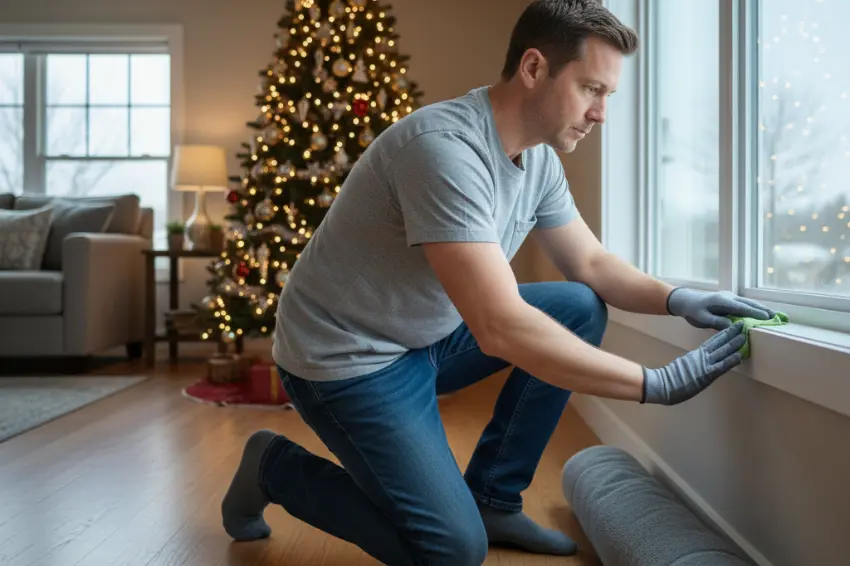
Monthly Maintenance Tasks (Year-Round)
Some things need attention every month, regardless of season. Build these into your routine:
HVAC Filter Changes
I mentioned this already, but it’s worth repeating. Every 30-60 days. Set a reminder. Buy in bulk. Just do it.
Garbage Disposal Care
Run ice cubes and citrus peels through monthly to clean blades and freshen it up. Never put grease, fibrous vegetables, or expandable foods (pasta, rice) down the disposal.
Check for Water Leaks
Do a quick visual check under sinks, around toilets, and near appliances with water connections. Catching a small leak early prevents major water damage.
Clean Range Hood Filter
Your kitchen range hood has a filter that traps grease. Pull it out monthly and run it through the dishwasher or soak it in hot, soapy water. A clean filter works better and reduces fire risk.
Test GFCI Outlets
Bathrooms and kitchens should have GFCI outlets (the ones with “test” and “reset” buttons). Press the test button monthly to ensure they’re working properly. These prevent electrical shocks in wet areas.
Essential Home Maintenance Tools
You don’t need a garage full of tools, but having the right basics makes maintenance way easier. Here’s what I actually use:
The Core Toolkit
The Anvil Homeowner’s Tool Set covers most basic needs—hammer, screwdrivers, pliers, tape measure, and more. It’s affordable and has everything in one organized case.
Add an Adjustable Wrench for plumbing fixes and furniture assembly. A good Cordless Drill (like the Ryobi with bit set) is essential for repairs and projects—I use mine constantly.
For bigger projects, a Circular Saw (DEWALT makes reliable ones) handles straight cuts efficiently. An Electric Sander is perfect for refinishing furniture or smoothing rough surfaces. And if you’re doing serious work, a Cordless Impact Driver provides extra power for tough materials.
Cleaning Arsenal
Stock up on Microfiber Cleaning Cloths—they’re reusable, affordable, and work better than paper towels for almost everything. An Extendable Duster reaches ceiling fans and high corners without a ladder.
For tough jobs, a Heavy-Duty Scrub Brush tackles grout, tiles, and exterior surfaces. Keep Degreaser Spray for kitchen messes and Bath & Tile Cleaner for bathrooms. Don’t forget a decent Toilet Brush with Holder (I know, not glamorous, but necessary).
Lysol All-Purpose Cleaner is a workhorse that’s safe for most surfaces. The Tineco Wet Dry Vacuum Mop is amazing if you want to step up your floor-cleaning game—it vacuums and mops simultaneously.
Maintenance Task Frequency Guide
Not sure when to do what? Here’s a quick reference:
| Task | Frequency | Season |
|---|---|---|
| Change HVAC filters | Monthly | Year-round |
| Test smoke/CO detectors | Monthly | Year-round |
| Check for leaks | Monthly | Year-round |
| Clean gutters | Twice yearly | Spring & Fall |
| Inspect roof | Annually | Spring |
| HVAC professional service | Annually | Spring for AC, Fall for heat |
| Chimney inspection/cleaning | Annually | Fall |
| Power wash exterior | Annually | Spring or Summer |
| Inspect weatherstripping | Annually | Fall |
| Deep clean appliances | Twice yearly | Spring & Summer |
| Lawn aeration | Annually | Spring |
| Winterize outdoor faucets | Once | Fall |
Why Preventative Maintenance Saves Money
I get it—spending time and money on maintenance when nothing’s broken feels counterintuitive. But trust me on this: preventative maintenance is always cheaper than emergency repairs.
A $30 HVAC filter change prevents a $300+ service call. Cleaning gutters prevents thousands in foundation or roof damage. A $100 chimney sweep prevents a house fire. These aren’t just chores—they’re investments in your home’s value and your financial security.
Plus, maintained homes last longer. You’ll extend the life of your roof, HVAC system, appliances, and more. That’s real money saved over time.
Making Maintenance Manageable
The secret to staying on top of home maintenance? Create a system. I use a simple calendar with reminders for monthly, seasonal, and annual tasks. Some people prefer apps, others use a physical checklist on the fridge.
Start small if you’re overwhelmed. Pick one monthly task (like changing HVAC filters) and build from there. You don’t have to do everything at once—even small steps make a difference.
Batch similar tasks together. When you’re cleaning gutters, inspect the roof at the same time. When you’re checking one smoke detector, check them all. Working efficiently saves time.
When to Call a Professional
DIY is great, but some jobs require professionals:
- Electrical work beyond changing outlets or light fixtures (safety first!)
- Major plumbing repairs (fixing a leaky faucet is fine, repiping your house is not)
- Roof repairs (unless you’re experienced and comfortable with heights)
- HVAC repairs (annual maintenance DIY is okay, but repairs need certification)
- Gas line anything (seriously, call a pro)
Don’t be penny-wise and pound-foolish. A botched DIY job can cost way more to fix than hiring a professional from the start. Know your limits, and there’s no shame in calling for backup.
Build Your Home Maintenance Habit
Home maintenance is really just a habit. Once you establish a routine, it becomes second nature. You’ll start noticing small issues before they become big problems. You’ll feel more confident in your ability to care for your home.
Start with the essentials: monthly HVAC filters, seasonal gutter cleaning, and safety checks. Build from there as you get comfortable. Your home is probably your biggest investment—giving it regular attention protects that investment and gives you peace of mind.
You’ve got this. Grab that Anvil Toolkit, set some calendar reminders, and tackle one task at a time. Your future self (and your wallet) will thank you.
Frequently Asked Questions
What are the most important monthly home maintenance tasks?
The big three are changing HVAC filters, testing smoke and carbon monoxide detectors, and doing a quick visual check for water leaks under sinks and around appliances. These take maybe 20 minutes total and prevent the most common (and expensive) home problems. Add cleaning your garbage disposal and checking GFCI outlets if you want to be extra thorough.
How often should I change my HVAC filters?
Every 30-60 days, depending on your household. If you have pets, allergies, or run your system constantly, lean toward 30 days. During mild months when you’re barely using heating or cooling, you can stretch to 60 days. Buy filters in bulk—they’re cheaper, and you’ll always have one ready. Set a recurring phone reminder because this is the easiest preventative maintenance that makes the biggest impact.
What’s the best way to clean gutters and prevent clogs?
Use a sturdy ladder, wear work gloves, and scoop out debris by hand into a bucket. Then flush gutters with a hose to remove remaining dirt and check that downspouts are clear. For prevention, consider installing gutter guards—they’re not perfect, but they block most leaves and significantly reduce cleaning frequency. If you hate heights, hire a professional twice a year (spring and fall). It typically costs $100-200 and is worth every penny for peace of mind.
How do I check for roof leaks or damage?
From the ground, use binoculars to inspect for missing, curling, or cracked shingles, especially after storms. Inside your attic, look for water stains, daylight coming through, or damp insulation—these are red flags. Check ceilings throughout your home for water stains or discoloration. If you spot any issues, call a roofing professional before a small leak becomes major interior damage. Don’t walk on your roof unless you’re experienced—it’s dangerous and you could cause more damage.
When should I test smoke and CO detectors?
Test them monthly by pressing the test button on each unit. Replace batteries twice a year—I do it when we change clocks for daylight saving time as an easy reminder. Replace the entire detector every 10 years (check the manufacturing date on the back). Never disable a detector because it’s “annoying”—that’s when tragedies happen. If a detector keeps chirping after a new battery, replace the whole unit immediately.
What is the easiest way to maintain my lawn and garden?
Keep it simple: mow regularly at the right height for your grass type (usually 2.5-3 inches), water deeply but infrequently (1 inch per week), and pull weeds when they’re small. In spring, aerate compacted areas and overseed bare spots. Add mulch to garden beds—it suppresses weeds and retains moisture, cutting your maintenance time significantly. Choose native plants when possible; they require less water and care. Don’t stress about a perfect lawn—healthy and well-maintained beats perfect every time.
How do I maintain kitchen appliances for longevity?
Clean refrigerator coils twice a year by pulling the fridge out and vacuuming the coils (usually on the back or bottom). Run your dishwasher empty with vinegar occasionally to clean buildup. Wipe down the dishwasher door seal monthly to prevent mold. For your oven, clean spills immediately before they bake on. Replace stove hood filters regularly—run them through the dishwasher or soak in degreaser. These small actions extend appliance life by years and prevent costly repairs.
What routine plumbing checks should I perform?
Monthly, check under every sink and around toilets for leaks, moisture, or water stains. Look behind appliances with water connections (washing machine, dishwasher). Test faucets and shower heads—if water pressure drops, you might have sediment buildup. Once a year, flush your water heater to remove sediment (check your manual). Know where your main water shutoff valve is and test it annually to ensure it works—if a pipe bursts, you need to shut off water immediately.
How often should I inspect electrical systems in my home?
Test GFCI outlets (the ones with test/reset buttons in bathrooms and kitchens) monthly. Check for warm outlets, flickering lights, or frequently tripping breakers—these indicate problems needing professional attention. Replace any cracked outlet covers. Have a licensed electrician inspect your full system every 3-5 years, or immediately if you notice any issues. Never ignore electrical problems—they’re fire hazards. If something seems off, call a professional right away.
What preventative measures can reduce major repairs?
The biggest money-savers are regular HVAC filter changes (prevents system breakdown), gutter cleaning (prevents foundation and roof damage), roof inspections (catches small issues before they become leaks), and plumbing leak checks (prevents water damage). Addressing small problems immediately—like a dripping faucet or loose shingle—stops them from becoming expensive emergencies. Think of preventative maintenance as insurance you pay in time rather than money. The hour you spend now saves thousands later.

